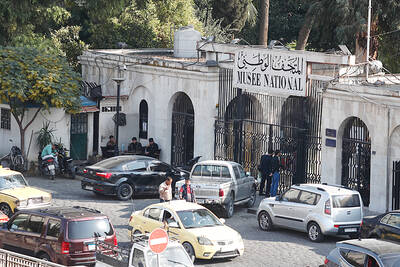The 125,000 slum-dwellers living under a lockdown so strict that drones monitor their movements and alert police if they attempt to leave home are at the heart of India’s push to contain COVID-19.
However, with only a handful of people tested so far in the nation’s biggest slum, fears are growing that “Mission Dharavi” — a term coined by officials working there — might not prevent the coronavirus from raging across the densely packed neighborhood.
Dharavi is home to an estimated 1 million people, who eke out a living as factory workers, or maids and chauffeurs to financial capital Mumbai’s well-heeled residents.

Photo: AFP
Its narrow alleys, crowded housing and poor sanitation offer the perfect breeding ground.
“The biggest challenge is Dharavi itself ... 10 to 15 people stay in one room. How is it possible to enforce social distancing?” official Kiran Dighavkar said.
He is overseeing an effort involving about 2,500 people, including medical workers, cleaners and volunteers, who are fighting to keep cases — at nearly 200, with 12 deaths — from spiraling out of control and overwhelming hospitals.
The severe lockdown imposed in five coronavirus hotspots in the slum since the first cases were reported earlier this month is a key part of that undertaking.
“No one is allowed to go in or out,” Dighavkar said, adding that “everything, including grocery shops, is shut.”
“Police are using drones to make sure people obey the rules,” he said.
A state-run school, a sports complex and a formerly defunct hospital are being used to house patients and as quarantine facilities.
About 40,000 people have undergone thermal screening over the past week at so-called fever camps and Dharavi’s 225 public toilets — a lifeline for residents — are disinfected daily, he said.
Officials have partnered with nonprofit organizations to distribute food and medicine in the area, also home to thousands of migrant workers left unemployed by a weeks-long nationwide lockdown.
Although the restrictions ordered across India are less severe than those imposed in Dharavi’s hotspots, they have had a lethal impact on the poor.
Roti Bank Foundation operations manager Jayandrath Tambe said that the nonprofit is organizing 4,500 meals daily for Dharavi’s confined residents and feeding 32,000 people across Mumbai with the help of local hotels.
Social worker Imran Idris Khan turned to YouTube to upload videos explaining relief efforts in Dharavi and used WhatsApp to inform residents about where to find food.
“Many families are still sitting at home or people are stuck in factories without any idea about food-packet distribution drives and therefore going hungry,” Khan said. “This should not be happening.”
Capital of Maharashtra state, Mumbai has recorded more than 3,000 cases among its 18 million population. The Indian government has reported more than 21,000 cases in the nation of 1.3 billion.
Maharashtra Chief Minister Uddhav Thackeray on Sunday wrote on Twitter that about 70 to 75 percent of coronavirus cases in the state “have very mild symptoms or are asymptomatic.”
Officials in Dharavi tried to ramp up testing by including residents without symptoms, but Mumbai city authority spokesman Vijay Khabale-Patil said that New Delhi rejected the move.
Under Indian government guidelines, asymptomatic people are tested only if they are high risk or have come into direct contact with an infected person.
Just 657 people have been tested in the slum, raising fears that hospitals — reportedly already at full capacity — would struggle to cope if there was an unexpected spike in severe cases.
One Dharavi resident receiving treatment for COVID-19 said that he had no symptoms for three weeks spent almost entirely indoors, before developing a sore throat and fever which refused to subside.
He has now been in hospital for nine days.
“I feel helpless at times, and worry about my family and neighborhood,” the 24-year-old said on condition of anonymity, as he fears being stigmatized. “Looking at so many people losing lives due to infections makes me feel terrible. Will we ever recover from this?”

Philippine President Ferdinand Marcos Jr yesterday vowed that those behind bogus flood control projects would be arrested before Christmas, days after deadly back-to-back typhoons left swathes of the country underwater. Scores of construction firm owners, government officials and lawmakers — including Marcos’ cousin congressman — have been accused of pocketing funds for substandard or so-called “ghost” infrastructure projects. The Philippine Department of Finance has estimated the nation’s economy lost up to 118.5 billion pesos (US$2 billion) since 2023 due to corruption in flood control projects. Criminal cases against most of the people implicated are nearly complete, Marcos told reporters. “We don’t file cases for

A feud has broken out between the top leaders of the far-right Alternative for Germany (AfD) party on whether to maintain close ties with Russia. The AfD leader Alice Weidel this week slammed planned visits to Russia by some party lawmakers, while coleader Tino Chrupalla voiced a defense of Russian President Vladimir Putin. The unusual split comes at a time when mainstream politicians have accused the anti-immigration AfD of acting as stooges for the Kremlin and even spying for Russia. The row has also erupted in a year in which the AfD is flying high, often polling above the record 20 percent it

Ecuadorans are today to vote on whether to allow the return of foreign military bases and the drafting of a new constitution that could give the country’s president more power. Voters are to decide on the presence of foreign military bases, which have been banned on Ecuadoran soil since 2008. A “yes” vote would likely bring the return of the US military to the Manta air base on the Pacific coast — once a hub for US anti-drug operations. Other questions concern ending public funding for political parties, reducing the number of lawmakers and creating an elected body that would

‘ATTACK ON CIVILIZATION’: The culture ministry released drawings of six missing statues representing the Roman goddess of Venus, the tallest of which was 40cm Investigators believe that the theft of several ancient statues dating back to the Roman era from Syria’s national museum was likely the work of an individual, not an organized gang, officials said on Wednesday. The National Museum of Damascus was closed after the heist was discovered early on Monday. The museum had reopened in January as the country recovers from a 14-year civil war and the fall of the 54-year al-Assad dynasty last year. On Wednesday, a security vehicle was parked outside the main gate of the museum in central Damascus while security guards stood nearby. People were not allowed in because